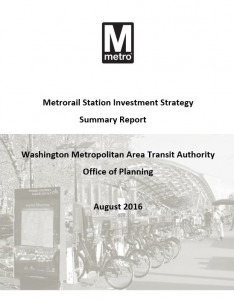Bike and Pedestrian Infrastructure – Quantifying the Return on Investment
Sometimes small investments yield large returns. Building sidewalks and bike lanes to Metrorail stations increases safety and pays off two to one.
To close the loop on the last post that described our station area bike/ped project selection and evaluation process, we’ve posted the summary report online for your reading pleasure. To skip right to the bottom line, though, we’ve been able to tie dollar amounts to certain project benefits and have calculated a total return on investment that’s nothing to sneeze at. In short, we’ve estimated that a $13 M investment in some of the 394 top pedestrian projects leads to a $24M discounted revenue impact for Metro and its funders of the course of these projects’ useful life, a net positive benefit of $11M. BAM!
In addition to the monetary returns, there are a number of other benefits that tend are challenging to quantify financially but have great value to customers and society at large. For example:
- New pathways shortens someone’s travel time, making Metro a more attractive option for the trip they are making;
- New sidewalks may open up the station to an ADA customer who had to rely paratransit before to get to where s/he was going; and
- New bike lanes provides a separation between both moving and parked cars, and the bicyclist, making her safer.
These projects are valuable indeed and the task before us (the royal ‘us’) is to ensure that they are built, thereby contributing to a more efficient use of the Metro system by maximizing the accessibility of stations. So, let’s get cracking!
Since we collected projects from planning documents going back a few years, we anticipated that some of them might already have been built or might no longer work in the current context. Therefore, we asked staff from our local transportation departments and planning agencies to help us “ground-truth” or update project status. Out of the 394 top projects, we removed 194 that were already completed, no longer under consideration or that have already been funded, leaving 200 to focus on.
Not bad for a day’s work!
The summary report includes maps showing where the most-needed projects are located, as well as a “scorecard” detailing each project’s potential benefits as calculated in the prioritization process. These include the safety measure defined by frequency of crashes proximate to the project, the potential ridership generated for certain projects, community facilities served, whether or not the project is located in a low income area (and, if so, how much of it falls in that area), the Walkscore, estimated cost, and a number of other useful indicators.



Recent Comments